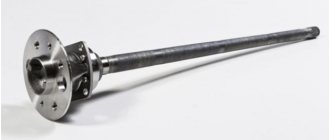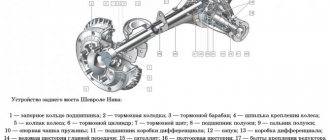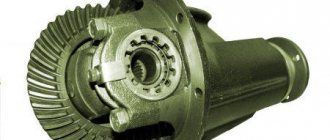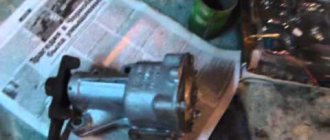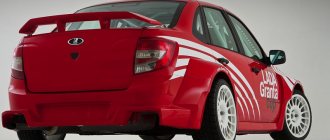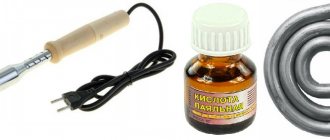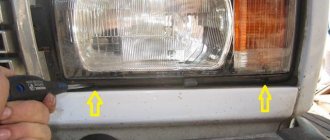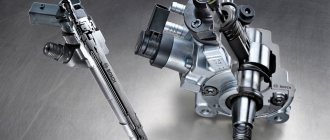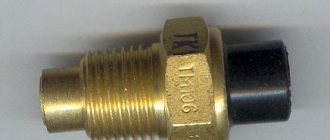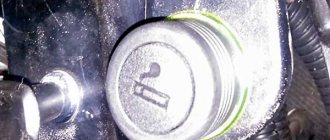WHAT ARE HAMI SHAPS, WHY ARE THEY NEEDED AND HOW ARE THEY STRUCTURED
In rear-wheel drive cars, which the “seven” actually belongs to, the rear wheels are driving. It is they, rotating, that make the car move. The torque is transmitted to them from the gearbox through the drive (cardan) shaft, gearbox and axle shafts. There are only two axle shafts: one for each rear wheel. Their role is to transmit torque from the corresponding gear of the gearbox to the wheel rim.
HALF AXLE DESIGN
The axle shaft is an all-metal shaft made of steel. At one end there is a flange for attaching the wheel disk, and at the other there are splines for engagement with the gearbox gear. If we consider the axle shaft assembly, then in addition to the shaft, its design also includes:
- oil deflector;
- sealing gasket;
- oil seal (cuff);
- bearing.
In addition to the shaft, the design of the axle shaft also includes an oil deflector, a gasket, an oil seal and a bearing.
Each of the axle shafts is installed in the corresponding (left or right) rear axle housing. An oil deflector with a gasket and an oil seal are used to prevent lubricant from leaking out of the casing. The bearing is designed to ensure uniform rotation of the axle shaft and distribute shock loads coming from the wheel to the rear axle of the vehicle.
1 — oil deflector; 2 - gasket; 3 - seal; 4 - oil seal; 5 - axle shaft; 6 - casing; 7 — bearing mounting plate; 8 — brake shield; 9 — bearing; 10 — fixing sleeve
Procedure for bearing replacement
To get to the faulty unit, you will have to remove the gearbox, clutch and flywheel. Carry out similar work on a lift, pit or overpass, using a special crankshaft bearing puller (a device for pressing out of blind holes).
The replacement procedure is as follows:
1.First, disassemble the crankshaft bearing removal tool into its component parts, otherwise you will damage the thread when installing it. After this, lubricate the conical protrusion on the puller bushing with engine oil or grease - this will protect its surface from damage.
2.Install the press-out spacer sleeve into the inner race of the bearing and drive the device in until it stops.
3.To remove the bearing from the crankshaft, do the following. First tighten the puller screw by hand. Then, holding the press-out sleeve from turning with a 14-point open-end wrench, tighten the screw with a 17-point socket. Resting against the blank wall of the hole in the crankshaft flange, the shank of the device moves out of the coupling, pushing it along with the bearing out of the socket.
4. Having removed the damaged part, wipe the seat in the crankshaft from dust and lubricate it with engine oil. Don’t forget to check and, if necessary, replenish the amount of lubricant in the new bearing - manufacturers often sin with excessive efficiency.
5. When installing the new VAZ 2107 crankshaft bearing in place, make sure that it does not warp. The final pressing is carried out with a hammer and a suitable mandrel. If one is not found, then use the dismantled unit or hammer the bearing with a hard rubber mallet.
6.Installation is complete when the top plane of the bearing is flush with the flange.
If you are unable to find a press-out, do not despair. Every experienced auto mechanic knows how to remove a bearing from a crankshaft without a tool. In this case, you will need: a drift with a diameter of 15 mm (you can use a suitable bolt) and plastic material - lithol, plasticine or bread crumb mixed with sawdust. It is placed through the opening in the inner race in such a way as to fill the space under the bearing. Then a drift is inserted into the hole and hit with a hammer. Expanding to the sides, the soft mixture squeezes the bearing out. This way you can replace the faulty unit and avoid troubles in the future.
Something else useful for you:
- How to replace the rear crankshaft oil seal of a VAZ with your own hands?
- How to replace the front crankshaft oil seal of a VAZ yourself?
- What are the types of engine knocks, causes, diagnostics?
MAIN TECHNICAL CHARACTERISTICS OF VAZ 2107 HALF AXLES AND THEIR ELEMENTS
Axle shafts for the “seven” in Russia are produced under catalog number 21030–2403069–00. The right and left parts, unlike some other rear-wheel drive cars, are absolutely identical in the VAZ 2107. They have a diameter of 30 mm (for the bearing) and 22 slots. On sale you can also find so-called reinforced axle shafts with 24 splines, but to install them you will need to change the design of the gearbox.
AXLE BEARING
The bearing is the element that bears most of the loads. And although its declared resource is about 150 thousand kilometers, it can become unusable much earlier. It all depends on the operating conditions of the car, the serviceability of other transmission parts, as well as the quality of its manufacture. The most reliable today are considered to be bearings from the Vologda Bearing Plant, produced under article numbers 2101–2403080 and 180306. Imported analogues have catalog number 6306 2RS.
TABLE: DIMENSIONS AND TECHNICAL CHARACTERISTICS OF BEARING 2101–2403080
| Position | Index |
| Type | Ball |
| Number of rows | 1 |
| Direction of loads | Two-way |
| Outer/inner diameter, mm | 72/30 |
| Width, mm | 19 |
| Load capacity dynamic/static, N | 28100/14600 |
| Weight, g | 350 |
STUFFING BOX
The axle shaft cuff has a much shorter lifespan than the bearing, since its main working material is rubber. It needs to be changed every 50 thousand kilometers. Axle shaft seals are available under catalog numbers 2101–2401034.
TABLE: DIMENSIONS AND TECHNICAL CHARACTERISTICS OF THE VAZ 2107 HALF AXLE SEAL
| Position | Index |
| Frame type | Rubberized |
| Type of rubber according to GOST | 8752–79 |
| Internal diameter, mm | 30 |
| Outer diameter, mm | 45 |
| Height, mm | 8 |
| Temperature range, 0С | -45 – +100 |
Illusory repair possibilities
It should be said right away that repairing throttle position sensors is extremely rare. Firstly, the part itself, even the most expensive one, costs only a few dollars, and it makes sense to spend the money. Secondly, in most cases it is simply impossible to make repairs, for example, to restore a worn-out base layer. However, in some models you can slightly shift the resistive tracks relative to the slider and thereby extend the life of the device.
So, there is a special screw on the sensors. With its help, the position of the tracks is fixed. If they are already worn out, then you should loosen this same screw, this will change the location of the slider a little, and you can be a little patient with replacing the device. But don't count on long-term respite. Naturally, we remember that the contactless sensor cannot be repaired. This completes the adjustment, repair and replacement of the throttle position sensor, now you can operate the car for several more years and not even think about such issues.
To check the supply voltage, disconnect the wire block from the sensor. Turn on the ignition and use a tester to measure the voltage between terminals “A” and “B” of the wire block. The supply voltage should be about 5V. To check the sensor, we connect the block of wires to it and, with the ignition on, measure the voltage (the wires of the block can be pierced with thin needles connected to the terminals of a voltmeter) between the sensor terminals “B” (“ground”) and “C” (slider) - it should not be more than 0.7V. Turning the plastic sector of the drive by hand, fully open the throttle valve and measure the voltage again - it should be more than 4V. Turning off the ignition, disconnect the wire block and connect an ohmmeter between terminals “C” and “A” (or “B”) of the sensor. Slowly turning the drive sector, we monitor the readings of the tester arrow. There should be no jumps in the needle throughout the entire working range. To replace the sensor, remove the throttle body from the receiver studs without disconnecting the coolant inlet and outlet hoses from it (see Removing the throttle body).
Using a Phillips screwdriver, unscrew the two screws securing the sensor to the throttle body...
...and remove the sensor.
The sensor is marked 2112-1148200
Remove the sealing foam ring installed under the sensor.
Install the sensor on the throttle body in reverse order. In this case, the damper must be in the closed position. The tightening torque for the sensor mounting screws is 2 N•m.
The VAZ 2107 throttle sensor, together with a mass air flow sensor and oxygen concentration control, acts as an element that controls the supply of fuel to the combustion chamber depending on the position of the throttle valve. As with any repair to replace electronic fuel injection sensors, they must be checked for functionality. To check, you will need a regular multimeter with the function of measuring resistance in the power circuit and a set of standard tools.
To check the throttle sensor:
- Disconnect the package with wires from the sensor.
- The connector body will be marked. Connect the ohmmeter leads to terminals “B” and “C”. We open the throttle valve; for a working sensor, the resistance will increase from 2.7 to 8.2 kOhm.
- Next, we switch the multimeter to voltmeter mode and connect its negative terminal to engine ground, turn on the ignition in the circuit, and the positive probe will turn on. For a working sensor, the voltage should be approximately equal to 5V, if absent or significantly different from the norm, there is a malfunction in the power circuit or in the computer. After measuring the voltage, turn off the ignition.
After confirming that the throttle sensor is not working and deciding to replace it, you must:
- To remove the sensor, use a Phillips screwdriver to unscrew the two screws securing it to the throttle body and remove it.
- There will be a foam gasket between the sensor and the housing.
At this point, the repair work to check and remove the VAZ 2107 throttle sensor is completed. The installation must be carried out with the damper closed, aligning the protrusion of the damper axis with the groove on the sensor body.
Sources
- https://carnovato.ru/proverka-regulirovka-datchika-polozhenija-drosselnoj-zaslonki/
- https://www.autofizik.ru/VAZ/VAZ-210721047/features-of-repair-of-a-VAZ-2107-20-with-engine-VAZ-2104/checking-and-replacing-position-sensor-d
- https://remont-vaz2106.ru/datchik-drosselnoj-zaslonki-vaz-2107
MALFUNCTIONS OF VAZ 2107 HALF AXLES, THEIR CAUSES AND SIGNS
The main failures of axle shafts include:
- shaft deformation;
- fracture;
- wear or cutting of splines;
- Damage to the wheel rim mounting threads.
DEFORMATION
The axle shaft, although made of high-strength steel, can become deformed under high loads. Such a malfunction is often a consequence of gearbox jamming, bearing problems, or the corresponding wheel falling into a deep pothole. A sign of deformation of the axle shaft is strong vibration of the wheel rim, sometimes accompanied by a hum, knocking, or crackling noise.
FRACTURE
The result of a wheel hitting a pothole or a strong impact on a bump can be a fracture of the axle shaft. In this case, the car loses control because one of the drive wheels stops rotating. If the axle shaft is broken, the gears of the gearbox may also fail, so if such a malfunction occurs, it must be checked.
WEAR OR CUT OFF SPLINES
Natural wear of the axle shaft splines may appear after 200–300 thousand kilometers. More often they are cut off, which occurs when one of the wheels jams and the gearbox malfunctions. Also, the splines are cut off due to wear of the axle gear teeth that mesh with them.
A sign of spline damage is a crunching noise from the gearbox.
A sign of wear or cutting of the splines is a crunch (crack) from the axle shaft, which usually occurs when starting or moving downhill. The crunching sound indicates that the gear teeth are slipping between the axle shaft splines.
DAMAGE TO WHEEL THREAD
It is quite difficult to damage the threads on the flange, but such troubles still happen. The reason for this may be non-compliance with the tightening torque of the wheel bolts, incorrectly set direction of the bolts when tightening, or violation of the thread pitch on the bolts. A sign of thread damage is vertical play in the wheel, or beating in the rear of the car while driving.
If the listed malfunctions are detected, the axle shaft (one or both) must be replaced. Continuing to drive a vehicle with faulty axle shafts is extremely dangerous.
Disassembling the mechanism
To replace a VAZ-2107 axle shaft or remove its bearing, you do not need to use an inspection hole or overpass. All work can be performed in the following order:
- Place a jack under the side to be repaired and loosen the wheel.
- Raise the car.
- Remove the entire wheel.
- Remove the brake mechanism. Please note that removing the brake drum is quite difficult. To do this, it is necessary to apply even blows with a hammer through a spacer made of a wooden block. The material from which the drum is made is very fragile. Therefore, when striking with a metal object, several pieces may break off.
- Remove the pads after first removing the springs.
- Unscrew the axle shaft using a 17mm socket.
After this, you need to pull the entire axle shaft out of its place. To do this, you need to take a wrench and install it between the brake cylinder and the rear of the axle shaft. The driver is used as a lever.
Replacing the axle shaft and axle seal of a VAZ 2107
Hi all ! every classic has this problem 1. We remove the brake drum, if there are guides, unscrew them with a wrench 2. Then we put a block and knock on the drum through it and, so that there is no distortion, we gradually turn the drum 3. Using a 17 socket head, we unscrew the four nuts through the holes in the axle flange 4 anyway, you don’t have a device for removing the axle shaft and therefore we pry it from the inside with a pry bar and push it out from the gearbox 5. remove the axle shaft from the bridge (the axle shaft is removed together with the oil seal, mounting plate, bearing and locking ring) 6. Using sliding pliers, remove the axle shaft oil seal from the socket in the rear axle beam 7. Using light blows of a hammer on the end head, press the new oil seal into the stocking of the rear axle of the VAZ 2106. If the axle shaft is deformed, there are large radial and axial clearances in the bearing, the locking ring is displaced, the splines are worn, the axle shaft must be replaced with a new assembly. Independent replacement of the VAZ 2107 axle bearing and lock ring is not recommended. Installation of the axle shaft on a VAZ 2107 is performed in the reverse order of removal. Before installation, lubricate the working surfaces of the oil seal with Litol-24 lubricant.
Changing the oil in the rear axle of a VAZ 2106
Often, car enthusiasts who own a vehicle such as the VAZ 2106 ask the same question. They are interested in which oil fluid is best suited for the rear axle of their car. At the same time, they ask - what volume is needed and how to change the oil?
There are different opinions. But experts recommend filling the rear axle gearboxes of this machine with transmission oil, which is marked 80W90. For example, this is Lukoil 80W90 GL. This group of oils also includes TAD-17 80W-90 or the so-called TNK.
When we've sorted out the oil, it's time to answer another question. Perhaps he is one of the most important. Namely, how much oil is required? So, the oil volume is as follows - 1.3 liters. At the same time, it is possible to change the oil in the gearbox. True, in this case you will need 1.4 liters.
As for the interval, it is necessary to change the oil fluid after every 30,000 kilometers of the vehicle. If you convert the mileage into a time frame, you get 3 years of operation.
The oil fluid is replaced in accordance with the established procedure:
- First of all, you need to use a lift or inspection hole. You will also need a key for “seventeen” and a hexagon for “twelve”.
- Next, unscrew the drain plug in the bridge and place a special container designed for draining the oil fluid. At the same time, the filler plug is also unscrewed. This is necessary so that the oil fluid flows out faster.
We unscrew the drain and filler bolts. When the oil fluid is drained from the bridge, the drain plug is screwed in and new oil is poured. Here you need to use the filler hole. You will also need a special syringe or other suitable tool.
Fill with a watering can
How to change the oil in the rear gearbox of a VAZ. Video
It would be a good idea to treat all components with washing liquid.
1. Wheel brake drum mounting bolt, 2. Guide pin; 3. Oil deflector of the axle bearing; 4. Brake drum; 5. Cast iron brake drum ring; 6. Rear brake wheel cylinder; 7. Fitting for bleeding the brake drive; 8. Axle bearing; 9. Bearing lock ring; 10. Rear axle beam flange: 11. Axle shaft oil seal; 12. Suspension spring support cup; 13. Rear axle beam; 14. Bracket for attaching the upper suspension rod; 15. Axle guide; 16. Differential bearing nut; 17. Differential box bearing; 18. Differential box bearing cover; 19. Breather; 20. Differential satellite; 21. Main gear driven gear; 22. Left axle shaft; 23. Axle gear; 24. Rear axle gear housing; 25. Drive gear adjusting ring; 26. Bearing spacer; 27. Drive gear bearing; 28. Drive gear oil seal; 29. Oil seal mud deflector; 30. Flange-fork of the cardan joint; 31. Nut; 32. Oil deflector; 33. Main gear drive gear; 34. Axle of satellites; 35. Axle gear support washer; 36. Differential box; 37. Right axle shaft; 38. Brackets for fastening suspension parts; 39. Thrust plate of the axle bearing; 40. Rear brake shield; 41. Rear brake pad; 42. Friction lining: 43. Axle shaft flange; 44. Locking plate; 45. Bearing cover mounting bolt.
What are axle shafts, why are they needed and how are they designed?
In rear-wheel drive cars, which the “seven” actually belongs to, the rear wheels are driving. It is they, rotating, that make the car move. The torque is transmitted to them from the gearbox through the drive (cardan) shaft, gearbox and axle shafts. There are only two axle shafts: one for each rear wheel. Their role is to transmit torque from the corresponding gear of the gearbox to the wheel rim.
Axle shaft design
The axle shaft is an all-metal shaft made of steel. At one end there is a flange for attaching the wheel disk, and at the other there are splines for engagement with the gearbox gear. If we consider the axle shaft assembly, then in addition to the shaft, its design also includes:
- oil deflector;
- sealing gasket;
- oil seal (cuff);
- bearing.
Each of the axle shafts is installed in the corresponding (left or right) rear axle housing. An oil deflector with a gasket and an oil seal are used to prevent lubricant from leaking out of the casing. The bearing is designed to ensure uniform rotation of the axle shaft and distribute shock loads coming from the wheel to the rear axle of the vehicle.
What functions do bearings perform?
With the help of axle shafts, rotation is transmitted from the rear axle gearbox to the wheels. The axle shaft itself is very reliable; it can only be broken during an accident. But the bearing, which ensures smooth and easy rotation when moving, fails much more often.
This usually happens due to frequent travel on uneven roads, sudden braking and acceleration. This mechanism is located directly next to the brake drums. That is why, in order to gain access to them, you need to remove the brake drums and pads, after which you need to completely remove the axle shaft.
Main technical characteristics of VAZ 2107 axle shafts and their elements
Axle shafts for the “seven” in Russia are produced under catalog number 21030–2403069–00. The right and left parts, unlike some other rear-wheel drive cars, are absolutely identical in the VAZ 2107. They have a diameter of 30 mm (for the bearing) and 22 slots. On sale you can also find so-called reinforced axle shafts with 24 splines, but to install them you will need to change the design of the gearbox.
Axle bearing
The bearing is the element that bears most of the loads. And although its declared resource is about 150 thousand kilometers, it can become unusable much earlier. It all depends on the operating conditions of the car, the serviceability of other transmission parts, as well as the quality of its manufacture. The most reliable today are considered to be bearings from the Vologda Bearing Plant, produced under article numbers 2101–2403080 and 180306. Imported analogues have catalog number 6306 2RS.
Table: dimensions and technical characteristics of bearing 2101–2403080
| Position | Index |
| Type | Ball |
| Number of rows | 1 |
| Direction of loads | Two-way |
| Outer/inner diameter, mm | 72/30 |
| Width, mm | 19 |
| Load capacity dynamic/static, N | 28100/14600 |
| Weight, g | 350 |
Stuffing box
The axle shaft cuff has a much shorter lifespan than the bearing, since its main working material is rubber. It needs to be changed every 50 thousand kilometers. Axle shaft seals are available under catalog numbers 2101–2401034.
Table: dimensions and technical characteristics of the VAZ 2107 axle shaft seal
| Position | Index |
| Frame type | Rubberized |
| Type of rubber according to GOST | 8752–79 |
| Internal diameter, mm | 30 |
| Outer diameter, mm | 45 |
| Height, mm | 8 |
| Temperature range, 0С | -45 – +100 |
What tools will you need?
In order to replace a VAZ-2107 axle shaft or bearing, you will need a standard set of tools:
- Jack.
- 19 mm wrench for unscrewing wheel bolts.
- Driver and set of socket heads.
- Hammer and chisel.
- Angle grinder, better known as an angle grinder.
- Several flathead and Phillips screwdrivers.
- Pliers.
- Reliable vice mounted on a workbench.
It is imperative to purchase a new bearing and oil seal for the VAZ-2107 axle shaft. Before carrying out work, it is advisable to find a small pipe that can be put on the axle shaft without any problems. With its help, a new bearing is installed.
Malfunctions of VAZ 2107 axle shafts, their causes and symptoms
The main failures of axle shafts include:
- shaft deformation;
- fracture;
- wear or cutting of splines;
- Damage to the wheel rim mounting threads.
Deformation
The axle shaft, although made of high-strength steel, can become deformed under high loads. Such a malfunction is often a consequence of gearbox jamming, bearing problems, or the corresponding wheel falling into a deep pothole. A sign of deformation of the axle shaft is strong vibration of the wheel rim, sometimes accompanied by a hum, knocking, or crackling noise.
Fracture
The result of a wheel hitting a pothole or a strong impact on a bump can be a fracture of the axle shaft. In this case, the car loses control because one of the drive wheels stops rotating. If the axle shaft is broken, the gears of the gearbox may also fail, so if such a malfunction occurs, it must be checked.
Worn or cut splines
Natural wear of the axle shaft splines may appear after 200–300 thousand kilometers. More often they are cut off, which occurs when one of the wheels jams and the gearbox malfunctions. Also, the splines are cut off due to wear of the axle gear teeth that mesh with them.
A sign of wear or cutting of the splines is a crunch (crack) from the axle shaft, which usually occurs when starting or moving downhill. The crunching sound indicates that the gear teeth are slipping between the axle shaft splines.
Damage to wheel threads
It is quite difficult to damage the threads on the flange, but such troubles still happen. The reason for this may be non-compliance with the tightening torque of the wheel bolts, incorrectly set direction of the bolts when tightening, or violation of the thread pitch on the bolts. A sign of thread damage is vertical play in the wheel, or beating in the rear of the car while driving.
If the listed malfunctions are detected, the axle shaft (one or both) must be replaced. Continuing to drive a vehicle with faulty axle shafts is extremely dangerous.
Installing a new bearing
Remove the old bearing - this can be done with a hammer. If it is stuck to the axle shaft, you can use a grinder. But before that, be sure to secure the entire structure in a vice. Follow these steps:
- Thoroughly clean the entire surface of the axle shaft, rinse it with solvent and wipe with a rag.
- Install the new bearing and secure its position using the retaining ring.
- Using a flat-head screwdriver, pull out the oil seal.
- Install a new oil seal; to do this, carefully hammer it in with a spacer. A 32mm socket is ideal.
After all the steps taken, it is necessary to install the rear axle shaft of the VAZ-2107 and assemble the wheel drive mechanism.
Replacing the axle shaft
Let's look at the process of replacing the axle shaft, its bearing and oil seal in detail. Tools you will need:
- wheel wrench;
- a jack and a safety stand (in extreme cases, a stump or a few bricks);
- wheel stops;
- reverse hammer;
- wrenches 8 mm, 17 mm;
- slotted screwdriver;
- Bulgarian;
- round nose pliers;
- hammer;
- chisel;
- workbench with a vice;
- blowtorch or gas torch;
- spacer made of wood or soft metal;
- a piece of steel pipe with a wall diameter of 33–35 mm;
- Litol type lubricant;
- dry clean rag.
Removing the axle shaft
To dismantle the axle shaft, you should:
- Place the car on a flat surface and place chocks under the front wheels.
- Use a wheel wrench to unscrew the wheel bolts.
- Raise the car body with a jack.
- Unscrew the wheel bolts and remove the wheel.
- Using a size 8 wrench, unscrew the drum guide pins.
- Remove the drum. If it does not come off the blocks, carefully knock it down using a spacer and a hammer.
- Using a 17mm wrench (preferably a socket), unscrew the nuts (4 pcs) securing the axle shaft. They are located behind the flange, but you can access them through specially provided holes by turning the axle shaft.
- Using round-nose pliers, remove the spring washers that are located under the axle nuts.
- Disconnect the axle shaft from the rear axle by pulling it towards you. If it does not give in, use a reverse hammer. To do this, the tool flange must be screwed to the axle flange with wheel bolts. By sharply moving the hammer weight forward, knock out the axle shaft. If you don't have a reverse hammer in your tool arsenal, you can use a removed wheel instead. It needs to be screwed with the back side to the axle shaft flange and struck with a hammer on the tire from the inside until the axle shaft comes out of the casing.
- Remove the axle shaft assembly with the bearing and its retaining ring.
- Remove the sealing gasket located between the brake shield and the axle shaft flange.
- Using round nose pliers or pliers, remove the oil seal from its seat.
How to remove a broken axle shaft
If the axle shaft is broken, it will not be possible to dismantle it in the usual way. But there are other methods. If the shaft breaks directly in front of the flange and its broken end sticks out of the bridge casing, you can weld a piece of reinforcement to it, and then use it to pull out the rest of the axle shaft.
If the axle shaft breaks inside the casing, you can try to knock it out with a piece of reinforcement inserted from the back side of the bridge, after first removing the opposite axle shaft. In extreme cases, to remove a piece of shaft, you will have to disassemble the gearbox.
Removing and installing the bearing on the axle shaft
When replacing the axle shaft with a new one, it is recommended to replace the bearing, but if the old one is still fully functional, you can install it too. But to remove it you will need to remove the retaining ring.
To do this you need:
- Securely fix the axle shaft in a vice.
- Using a grinder, saw through the outer part of the ring.
- Crack the ring body using a chisel and hammer.
- Remove the remaining ring from the shaft.
- Carefully knock the bearing off the axle shaft using the same tools. Apply blows only to the inner race of the bearing. Otherwise, you will damage it and will no longer be able to use it.
- Inspect the new axle shaft and bearing for manufacturing defects.
- Remove the rubber boot from the bearing housing.
- Place grease between the bearing races.
- Reinstall the boot.
- Place the bearing on the axle shaft. Be careful: the bearing is installed so that the boot “looks” at the oil deflector.
- Place a piece of steel pipe against the bearing so that its walls rest against the end of the inner race.
- Applying gentle blows with a hammer to the opposite end of the pipe, seat the bearing in its place.
- Use a blowtorch or gas torch (you can use a burner from a regular kitchen gas stove) to heat the retaining ring. Don’t overdo it: you don’t need to heat it until red hot, but until there is a white coating on the surfaces.
- Using pliers, place the ring on the axle shaft.
- Shrink the ring by hitting it lightly with the back of the hammer. To make it cool faster, pour motor oil on it.
Installing the oil seal
To install a new oil seal:
- Wipe the seat with a clean, dry cloth.
- Lubricate the socket surfaces with grease.
- Lubricate the oil seal itself with grease.
- Install the part into the mounting socket.
- Using a hammer and a piece of pipe, carefully press in the oil seal.
Installing the axle shaft
Once the bearing and seal are installed, you can install the axle shaft. Installation is carried out in the following order:
- We install the sealing gasket.
- Insert the axle shaft into the housing until it stops. Check how the splines engage with the gear teeth by turning the axle shaft in different directions.
- Apply a few gentle blows with a hammer to the axle shaft flange to make sure it is seated correctly.
- Install spring washers onto the axle shaft studs. Install and tighten the nuts securing the axle shaft with a 17 mm socket wrench.
- Place the drum on the shoes and secure it with guide pins.
- Mount the wheel.
- Check to see if there is any play in the axle shaft or bearing by trying to shake the wheel along the vertical and horizontal axes.
- Lower the body and remove the chocks from under the front wheels.
- Tighten the wheel bolts.
- Check whether the signs of axle shaft malfunction have disappeared by driving on a flat section of the road.
Causes of failure
Every part on a car tends to become unusable. Rear wheel bearings are no exception, but any part has characteristic operational features. If the operating conditions are met, the part can serve for years, which is confirmed by the driving experience of current older drivers.
The main reasons for bearing failure are:
- careless driving;
- incorrect installation of the product;
- water and dust getting inside the hub;
- leakage of lubricant;
- long service life.
If a VAZ-2107 car is often operated in aggressive conditions close to off-road, then the need to replace the rear wheel bearing will not take long to arrive.
It is especially important to take into account the fact that the famous “seven” is a rear-wheel drive car. But how can you determine that a wheel bearing has failed and needs to be replaced? Let's find out in more detail
Methods for determining whether a wheel bearing is faulty
Timely identification of a malfunction allows you to prevent unpleasant consequences that can provoke an emergency situation on the road. The part in question on the VAZ-2107 car plays an important role, since thanks to this product the wheel rotates easily. The car has 2 rear wheel bearings, one for each rear wheel.
The main way to determine the malfunction of an important part of the hub on a VAZ-2107 is to carry out the following manipulations:
- raise the rear of the car on a jack;
- swing the outer part of the wheel in different directions;
- if a knocking noise occurs and the wheel dangles, then the rear wheel bearing of the VAZ-2107 needs to be replaced.
If the car drives while turning corners and a squeaking noise appears, this also indicates the need for repair work. To replace the wheel bearing, you will need the following tools:
- jack;
- wrenches and screwdrivers;
- chisel and hammer;
- puller;
- Litol brand lubricant.
After making sure that you have a complete list of tools and materials for the work, you can begin replacement.
Replacing a faulty product
You must begin replacing the product by loosening the wheel bolts. This must be done before the rear of the car is jacked up. At the same time, do not forget to install stops under the front wheels.
- A jack is installed, then the rear side of the car where the bearing needs to be replaced is jacked up. Once the car is raised, you can install a safety stump in case the jack comes off.
- The wheel is removed, and then the drum. It should be remembered that you cannot put the car on the handbrake, otherwise you will not be able to remove the drum. To remove the drum, you need to unscrew two pins and insert them into the technological holes. When the pins are tightened, the drum is pulled out, after which it can be dismantled.
- Using a screwdriver, pry off the steel cap or protective cover. The 4 nuts securing the axle shaft are unscrewed.
- We use a special puller, with the help of which the hub is removed from the drive axle axle. If there is no puller, then you can use a regular chain or cable, attaching it to the axle shaft.
- It is necessary to remove the worn bearing from the axle shaft using a puller or grinder. To remove the bearing using a grinder, you need to cut the outer race on both sides.
We make a cut to remove the old part
- Before pressing in a new product, it is necessary to thoroughly lubricate the seat on the axle shaft and in the hub. The bearing must be pressed in using a locking sleeve.
- The bushing must be heated with a blowtorch, then put on the axle shaft and cooled with water.
Further actions are performed in the reverse order of removal
It is important not to forget that when replacing a bearing, the sealing seals must also be replaced.
The bearing must not be misaligned, which can lead to its failure on the very first day of operation. If you operate the car correctly and carefully, then you can forget about replacing the bearing for 2-5 years. You can also read about replacing the front wheel hub bearing.
Repair of axle shaft on VAZ 2107
The VAZ "Seven" drive is carried out to the rear axle, which has a rather complex device. The most common failure of this unit is wear of the axle bearing. The external manifestations of such a malfunction on a VAZ 2107 car consist of a characteristic hum while driving. If the unit is not replaced on time, the bearing may be destroyed while driving and the wheel may jam.
Elimination of this malfunction of the rear axle on a VAZ 2107 car can be done in two ways. In the first case, the assembly is repaired with the installation of a new bearing; in the second case, the entire assembly is replaced. List of necessary tools and devices:
- a set of wrenches and screwdrivers;
- device for dismantling the unit from the rear axle;
- blowtorch or industrial hair dryer;
- device for removing the bearing thrust ring;
- pliers;
- mandrel for installing the retaining ring.
The listed devices are usually used at service stations. In garage conditions, slightly different techniques are used that do not require so much special equipment.
Replacing the front wheel bearing
Work on replacing a wheel bearing begins with the preparation of tools and materials. You will need:
- set of socket wrenches;
- screwdriver;
- chisel;
- hammer;
- pliers;
- extension for knocking out the bearing race;
- new bearing, seal and lubricant;
- rags;
- kerosene.
How to remove
To dismantle the part, lift the front wheel using a jack. In a service station, work is carried out on a lift. When replacing a bearing, the following sequence of actions must be performed:
- Unscrew the fasteners and remove the wheel.
- Unscrew the fastening and dismantle the caliper.
- Using a screwdriver, pry up the protective cap of the hub and remove it.
- Align the side of the hub nut.
- Unscrew the nut and remove it along with the washer.
- Dismantle the hub.
- Remove the outer bearing cage.
- Using a tool and a hammer, knock out the outer part cage from the hub.
- Pull out the ring that separates both wheel bearings and the oil seal.
- Knock out the inner race.
- Using kerosene and rags, clean the seat from dirt.
How to put
After dismantling the wheel bearings and cleaning the hub itself, you can begin installing new parts. The work is performed in the following order:
- Press in the races of both bearings.
- Apply lubricant to the separator and insert it inside the hub.
- The space between the bearings is filled with lubricant.
- Insert the spacer ring.
- Install a new seal.
- Install the hub onto the steering knuckle axis.
- Apply lubricant to the outer cage and place it in the bearing race.
- Place the washer in place and tighten the hub nut until it stops.
- After replacing the wheel bearings, adjustments are made by smoothly unscrewing the nut and ensuring that the hub rotates freely, but there is no play.
- Strike the side of the nut with a chisel, which will prevent it from unscrewing arbitrarily.
- Place the caliper in place and tighten the fasteners.
- Install the protective cap and wheel and tighten the bolts.
- They lower the car.
Video: how to replace the front wheel bearings of a VAZ 2107
What to lubricate
Litol-24 is used to lubricate wheel bearing separators. It is also used to apply a new oil seal to the working edge during installation.
Bearing nut tightening torque
The need to tighten the hub nut arises after replacing the bearings or during their adjustment. The nut is tightened using a torque wrench to a torque of 9.6 Nm, while the hub is turned several times to install the bearings in place. Then loosen the nut and tighten it again, but with a torque of 6.8 Nm, after which it is locked in this position.
The hub nut is tightened with a torque wrench
PROCEDURE FOR DISASSEMBLYING THE UNIT AND REMOVING THE BEARING
Repair of the rear axle of a VAZ 2107 is carried out in the following sequence:
- The machine is installed on a level surface, secured with a parking brake and stops. The desired side is raised with a jack, the wheel is removed and the body is lowered onto a strong support.
- The screws securing the drum to the hub are unscrewed and the part is removed. The brake mechanism is cleaned of dirt and disassembled. Using a socket wrench, unscrew the bearing cap bolts through the windows in the hubs.
- If the brake pads are worn excessively, they will need to be replaced together with the pads.
- At the next stage, we try to remove the faulty axle shaft; this is easy to do using a special tool. If there is no such device, then pressing is done using a wheel disk. We fasten it to the hub with two bolts and knock the bearing out of its seat with sharp blows on the rim.
- If the axle shaft assembly is being replaced, then we put a new one in place of the faulty unit and reassemble it in the reverse order.
If you plan to repair the unit of a VAZ 2107 car, then it is necessary to disassemble it and then replace the bearing.
How to change a bearing?
Repair and replacement work can be done in the garage or outside. The main thing is to choose a relatively flat surface to work on, so that the car stands more stable during repairs.
To begin, stock up on the necessary tools, prepare a socket wrench (or an open-end wrench) for “ten”, a socket wrench for “seventeen” (if you have a head of this diameter, then this is only a plus), prepare a jack.
Please note that a regular “17” key is not very convenient to use, so it is better to optimize the tool - weld the head to the collar in the shape of the letter “T”.
It is better to buy spare parts after you have taken everything apart, since there are times when after dismantling you will have to buy a new axle shaft.
So, you will need:
Brand new bearing
axle shaft seal,
locking sleeve.
The sequence of actions for changing the bearing on a VAZ 2107 axle shaft:
1. Place the machine on a flat surface, install the locking shoes on the rear wheel and the front wheel on the other side.
2. Slightly unscrew the screws on the rear wheel and jack up the car.
3. Install a special support that will protect one of the sides of the car from accidentally falling. Alternatively, you can use an empty metal canister.
4. Unscrew the bolts completely and remove the wheel.
5. Using a ten-point socket wrench, screw in the guides and carefully “squeeze out” the brake drum (the easiest way is to knock it down using a wooden block and a hammer).
If these methods do not help, then try another method. Make sure that the car is well secured, depress the clutch, put the gearshift knob in the second gear position, start the engine, release the clutch, spin the silent drum (do not accelerate too much). After this, press the brake pedal sharply. As a rule, after just a few attempts the drum can be easily removed.
6. Using a “seventeen” wrench, through the special holes in the flange, unscrew the fastening bolts that secure the axle shaft.
7. Remove the axle shaft. If this cannot be done, place the wheel on two bolts and, tugging it (the movements should be as sharp as possible), remove the product. If it does not give in, then proceed by rocking.
Next, proceed to replace the bearing. Please note that if you do not have a special puller at hand, this operation will take you much longer.
RESTORING THE OPERATION OF THE UNIT
To fix the problem, you need to remove the old retaining ring. If a special device is not available, then the operation can be performed using a grinder. The ring is carefully cut off without damaging the axle shaft. This part is for single use and must be replaced every time the unit is repaired. The new bearing is put on the axle and secured with a new ring, which is preheated.
Repairing a component such as an axle shaft on a VAZ 2107 does not take much time from an experienced specialist. At the same time, going to a service station does not always guarantee a good result; often, in the absence of special devices, they simply knock down the ring with a sledgehammer, which leads to runout and rapid destruction of the bearing.
Sequencing
- The car is jacked up, and the wheel is removed using socket wrenches, behind which there is a worn bearing.
- The brake disc and pads are removed.
- Now you need to unscrew the axle shaft itself with a 17 socket wrench.
The axle shaft is unscrewed with a 17 socket wrench - To remove it from its seat, you can use a crank.
It should be inserted between the brake cylinder and the rear of the axle and used as a lever to push the axle out. Pushing out the axle shaft using a crank - Now you need to remove the bearing from the axle shaft.
Often it turns out to be tightly welded to it, so you have to literally cut it off with a grinder. This must be done by first clamping the axle shaft in a vice. The old bearing is cut off with a grinder - Once the old bearing is removed, the axle must be thoroughly wiped with a rag.
And then a new part and a retaining ring are put on the axle shaft. Installing a new axle bearing - Now, using a medium-sized flat-head screwdriver, you need to remove the worn oil seal from the seat.
The old oil seal is removed with a screwdriver - As soon as it is removed, a new oil seal is installed in its place (it is most convenient to drive it into the seat with a 32 socket head).
- The axle shaft with a new bearing is installed back into the seat and the entire assembly is reassembled.
Step-by-step instruction
- Loosen the wheel bolts, jack up and remove the wheel.
- Remove the brake drum.
Using pliers, remove the “soldiers” and remove the tension springs of the pads.
Remove the rear brake pads and set them aside.
Unscrew the 4 nuts securing the axle shaft. Head nuts for seventeen.
Push the hub towards you using the mounting lever and remove the axle shaft. If the axle shaft cannot be removed, use a three-legged puller.
Use a grinder to cut the retaining ring. It is better to make the cut a little not completely and cut through the remaining rings with a chisel. In order not to damage the axle shaft, make the cut very carefully.
Use a chisel or drift to knock the bearing out of its seat on the axle shaft. In our case, only the bearing race remained.
Place the bearing on the drive and use a pipe and a hammer to press it into place. As a rule, seating a bearing is quite easy.
- The bearing retaining ring is hot pressed. Take the ring and secure it to a piece of wire. Next, light the gas burner and heat the ring almost to red.
- Have a helper hold the axle shaft upright and keep the pipe and hammer handy. Next, use pliers to put the hot ring on the drive, and then, without hesitation, an assistant puts it in place using a pipe and a hammer.
Using a slotted screwdriver, remove the oil seal from its seat.Using a piece of pipe along the outer diameter of the oil seal, press it into place.
- Install the rubber O-ring.
- Install the axle shaft into the seat until it stops.
- Fit the fastening nuts and tighten them in a cross pattern with a force of 50 Nm.
- Install the brake pads, drum and wheel.
You can see the procedure in this video:
